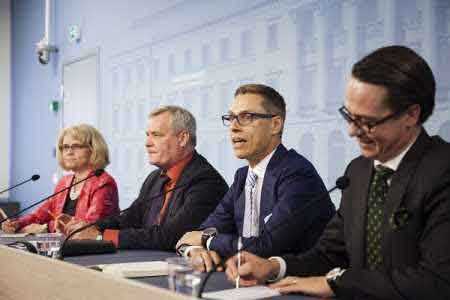|
Sat, 01 Nov, 2014 12:00:30 AM FTimes- Xinhua Report, Nov. 01  File picture of the leaders of four-party alliance government. Photo Lehtikuva. The government policy program Finland is currently following has just about run out of steam, having been written back in 2011 when former Prime Minister Jyrki Katainen cobbled together his coalition government.
Since then, much has changed: the technology giant Nokia has been brutally scaled back, the impact of the ageing population is more keenly felt, the Ukrainian situation, and the declining Russian economy have all taken their toll on Finland.
Leading analysts from two research institutes, Vesa Vihriala the Research Institute of the Finnish Economy (ETLA) and Pasi Holm of the Pellervo Economic Research Institute (PTT), are looking to the next administration to "reset the policy agenda." Both say the successive government's structural reform agenda should include the public sector.
Vihriala pointed out that the current caretaker government is encouragingly pushing ahead with an ambitious reform of the social and health care sectors charted by the Katainen administration. However his PTT colleague said the post-election administration may want to consider "moving resources from the public to the private sector."
"We have to have a strategy not to increase public sector spending, or to increase it less than tax revenues. So that in long term we can gradually move to the private sector. It also means we have to decrease the number of workers in the public sector. The age structure helps because many older persons will retire, allowing us to move young people to the private sector," said Holm.
Finnish policy makers will have to keep an eye on external factors that could derail the best laid plans of economists and public servants.
With around 10 percent of its exports bound for Russia, Finland has also felt the pinch of the decline in the Russian economy as well as the embargo stand-off between Russia and the West over the situation in Ukraine. The Russian embargo on imported foods has affected the Finnish agri-sector, while the general unease about the situation has dimmed the short-term outlook for many businesses, Holm noted.
But Vihriala said, at most, the impact of the embargo and crisis situation can be measured at roughly 1 percent of GDP over a year.
"We reduced our forecast for 2015 from 2 percent growth to 0.8 percent growth just a month ago. The impact of the Russian economy and the entire crisis in Ukraine - through uncertainty - has been factored into that," Vihriala pointed out.
Big national players like Nokia and the pulp and paper sector played a major role in Finland's recovery from a painful and dramatic economic decline in the 1990s, when GDP plunged to -8 and unemployment bottomed out at a staggering 18 percent.
Although there are hopes for long-term recovery, neither research analyst thinks the country will be rescued by similar phenomena, despite new potential for manufacturing competitiveness offered by innovative approaches to automation and computerization.
"I don't think that small countries in the Nordic countries or in Europe in general are in a very good position in that regard because there's no wide domestic market, which is a key element for bringing back manufacturing because of automation breakthroughs," Vihriala remarked.
Instead, both see the country leveraging its skilled workforce and technology expertise to develop new products and services that can easily be scaled up, and where the country's remote geographical location would not be a disadvantage - such as in the burgeoning gaming sector.
Holm and Vihriala concur on another point that would provide little comfort for the common man: the Finnish economy won't be turning the corner any time soon.
"It will take 5 to 10 years before Finland can once more become an important player," Holm said, adding that he's hopeful that a new administration will be able to wipe the slate clean and really focus on implementing much-needed internal reforms.
"A rather difficult period is still ahead in 2015 and 2016 but I have an underlying confidence in the Finnish economy because we've been able to come out of much more difficult situations before," noted Vihriala.
However, he remained positive of the outcome: "What we saw in the early 1990s was a huge crisis of the scale and size and the nature of what Spain, for example, has been going through recently. We recovered from that quite strongly. And the economy that came out of that crisis was much stronger in structural terms than what we had before that."
Perhaps these two seasoned analysts have hit on the essential formula required for this small, but resilient, Nordic nation to endure its latest trials: a dose of clear-eyed realism, combined with hard work and cautious optimism for the future.
More News
|
|
Finland Times
| Monday, 29 April, 2024 |

